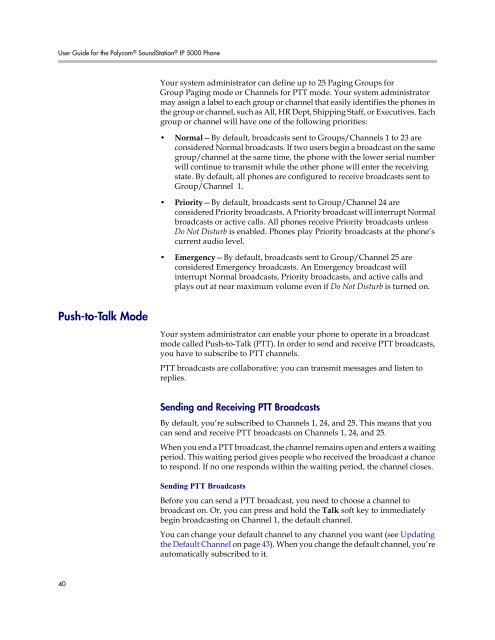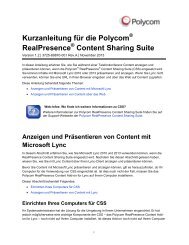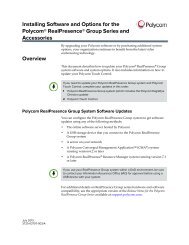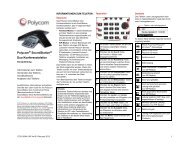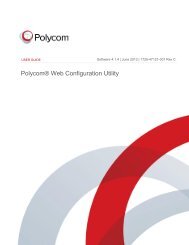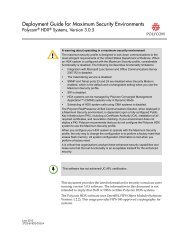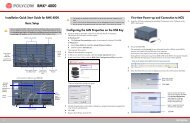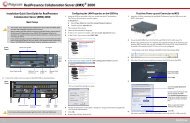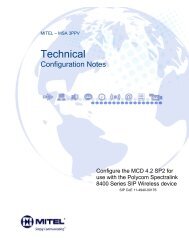User Guide for the Polycom SoundStation IP 5000 Phone
User Guide for the Polycom SoundStation IP 5000 Phone
User Guide for the Polycom SoundStation IP 5000 Phone
You also want an ePaper? Increase the reach of your titles
YUMPU automatically turns print PDFs into web optimized ePapers that Google loves.
<strong>User</strong> <strong>Guide</strong> <strong>for</strong> <strong>the</strong> <strong>Polycom</strong> ® <strong>SoundStation</strong> ® <strong>IP</strong> <strong>5000</strong> <strong>Phone</strong><br />
Push-to-Talk Mode<br />
40<br />
Your system administrator can define up to 25 Paging Groups <strong>for</strong><br />
Group Paging mode or Channels <strong>for</strong> PTT mode. Your system administrator<br />
may assign a label to each group or channel that easily identifies <strong>the</strong> phones in<br />
<strong>the</strong> group or channel, such as All, HR Dept, Shipping Staff, or Executives. Each<br />
group or channel will have one of <strong>the</strong> following priorities:<br />
• Normal—By default, broadcasts sent to Groups/Channels 1 to 23 are<br />
considered Normal broadcasts. If two users begin a broadcast on <strong>the</strong> same<br />
group/channel at <strong>the</strong> same time, <strong>the</strong> phone with <strong>the</strong> lower serial number<br />
will continue to transmit while <strong>the</strong> o<strong>the</strong>r phone will enter <strong>the</strong> receiving<br />
state. By default, all phones are configured to receive broadcasts sent to<br />
Group/Channel 1.<br />
• Priority—By default, broadcasts sent to Group/Channel 24 are<br />
considered Priority broadcasts. A Priority broadcast will interrupt Normal<br />
broadcasts or active calls. All phones receive Priority broadcasts unless<br />
Do Not Disturb is enabled. <strong>Phone</strong>s play Priority broadcasts at <strong>the</strong> phone’s<br />
current audio level.<br />
• Emergency—By default, broadcasts sent to Group/Channel 25 are<br />
considered Emergency broadcasts. An Emergency broadcast will<br />
interrupt Normal broadcasts, Priority broadcasts, and active calls and<br />
plays out at near maximum volume even if Do Not Disturb is turned on.<br />
Your system administrator can enable your phone to operate in a broadcast<br />
mode called Push-to-Talk (PTT). In order to send and receive PTT broadcasts,<br />
you have to subscribe to PTT channels.<br />
PTT broadcasts are collaborative: you can transmit messages and listen to<br />
replies.<br />
Sending and Receiving PTT Broadcasts<br />
By default, you’re subscribed to Channels 1, 24, and 25. This means that you<br />
can send and receive PTT broadcasts on Channels 1, 24, and 25.<br />
When you end a PTT broadcast, <strong>the</strong> channel remains open and enters a waiting<br />
period. This waiting period gives people who received <strong>the</strong> broadcast a chance<br />
to respond. If no one responds within <strong>the</strong> waiting period, <strong>the</strong> channel closes.<br />
Sending PTT Broadcasts<br />
Be<strong>for</strong>e you can send a PTT broadcast, you need to choose a channel to<br />
broadcast on. Or, you can press and hold <strong>the</strong> Talk soft key to immediately<br />
begin broadcasting on Channel 1, <strong>the</strong> default channel.<br />
You can change your default channel to any channel you want (see Updating<br />
<strong>the</strong> Default Channel on page 43). When you change <strong>the</strong> default channel, you’re<br />
automatically subscribed to it.


